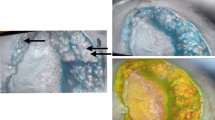Abstract
Background
Wound complications including infection and necrosis remain common during complex open ventral hernia repair. Advancements or enhancements in imaging technology may abate some of these issues but requires more investigation. Laser-assisted fluorescent imaging with indocyanine green (Spy Elite, LifeCell Corporation, Branchburg, NJ) allows visualization and quantification of perfusion, facilitating management of poorly perfused tissue.
Methods
Ten patients, who underwent large or massive ventral or incisional hernia repair with biologic graft reinforcement and either perforator-sparing components separation or primary open repair, underwent intraoperative laser-assisted fluorescent imaging with indocyanine green from August 2012 to August 2013. The cases were reviewed by an independent data collector with primary outcomes of postoperative skin infection and/or abdominal wall necrosis.
Results
Three (30 %) patients had adequate perfusion, while seven (70 %) patients had inadequate skin perfusion and necessitated excision of additional tissue. Of the patients whose ischemic tissue was removed, four (57 %) patients had an infection and no patients developed necrosis postoperatively. Of the patients who had no removal of additional skin, one (33 %) patient developed an infection and one (33 %) patients developed skin necrosis.
Conclusion
The intraoperative use of laser-assisted fluorescent imaging with indocyanine green may change management of abdominal wall flaps, even in perforator-sparing operations. Our study series is small and cannot suggest statistical significance in the potential benefit of intraoperative imaging, but shows that up to 70 % of patients may require change in management due to poorly perfused tissue flaps.
Similar content being viewed by others
References
Berger RL, Li LT, Hicks SC, Davila JA, Kao LS, Liang MK (2013) Development and validation of a risk-stratification score for surgical site occurrence and surgical site infection after open ventral hernia repair. J Am Coll Surg 217:974–982. doi:10.1016/j.jamcollsurg.2013.08.003
Luijendijk RW, Hop WC, van den Tol MP, de Lange DC, Braaksma MM, IJzermans JN, Boelhouwer RU, de Vries BC, Salu MK, Wereldsma JC, Bruijninckx CM, Jeekel J (2000) A comparison of suture repair with mesh repair for incisional hernia. N Engl J Med 343:392–398. doi:10.1056/NEJM200008103430603
Ventral Hernia Working Group, Breuing K, Butler CE, Ferzoco S, Franz M, Hultman CS, Kilbridge JF, Rosen M, Silverman RP, Vargo D (2010) Incisional ventral hernias: review of the literature and recommendations regarding the grading and technique of repair. Surgery 148:544–558. doi:10.1016/j.surg.2010.01.008
Darehzereshki A, Goldfarb M, Zehetner J, Moazzez A, Lipham JC, Mason RJ, Katkhouda N (2014) Biologic versus nonbiologic mesh in ventral hernia repair: a systematic review and meta-analysis. World J Surg 38:40–50. doi:10.1007/s00268-013-2232-1
Sbitany H, Kwon E, Chern H, Finlayson E, Varma MG, Hansen SL (2013) Outcomes Analysis of Biologic Mesh Use for Abdominal Wall Reconstruction in Clean-Contaminated and Contaminated Ventral Hernia Repair. Ann Plast Surg. doi:10.1097/SAP.0000000000000030
Ramirez OM, Ruas E, Dellon AL (1990) “Components separation” method for closure of abdominal-wall defects: an anatomic and clinical study. Plast Reconstr Surg 86:519–526
Wang HD, Singh DP (2013) The use of indocyanine green angiography to prevent wound complications in ventral hernia repair with open components separation technique. Hernia J Hernias Abdom Wall Surg 17:397–402. doi:10.1007/s10029-012-0935-0
Morris LM, LeBlanc KA (2013) Components separation technique utilizing an intraperitoneal biologic and an onlay lightweight polypropylene mesh: “a sandwich technique”. Hernia 17:45–51. doi:10.1007/s10029-012-0949-7
Gurtner GC, Jones GE, Neligan PC, Newman MI, Phillips BT, Sacks JM, Zenn MR (2013) Intraoperative laser angiography using the SPY system: review of the literature and recommendations for use. Ann Surg Innov Res 7:1. doi:10.1186/1750-1164-7-1
Phillips BT, Lanier ST, Conkling N, Wang ED, Dagum AB, Ganz JC, Khan SU, Bui DT (2012) Intraoperative perfusion techniques can accurately predict mastectomy skin flap necrosis in breast reconstruction: results of a prospective trial. Plast Reconstr Surg 129:778e–788e. doi:10.1097/PRS.0b013e31824a2ae8
Patel KM, Bhanot P, Franklin B, Albino F, Nahabedian MY (2013) Use of intraoperative indocyanin-green angiography to minimize wound healing complications in abdominal wall reconstruction. J Plast Surg Hand Surg 47:476–480. doi:10.3109/2000656X.2013.787085
Komorowska-Timek E, Gurtner GC (2010) Intraoperative perfusion mapping with laser-assisted indocyanine green imaging can predict and prevent complications in immediate breast reconstruction. Plast Reconstr Surg 125:1065–1073. doi:10.1097/PRS.0b013e3181d17f80
Newman MI, Jack MC, Samson MC (2013) SPY-Q analysis toolkit values potentially predict mastectomy flap necrosis. Ann Plast Surg 70:595–598. doi:10.1097/SAP.0b013e3182650b4e
Disclosures
Shawn Tsuda is a consultant for LifeCell Corporation. Jonathan Cho, Audriene May, and Heidi Ryan have no conflicts of interest to disclose.
Author information
Authors and Affiliations
Corresponding authors
Rights and permissions
About this article
Cite this article
Cho, J., May, A., Ryan, H. et al. Intraoperative use of fluorescent imaging with indocyanine green changes management of abdominal wall flaps during open ventral hernia repair. Surg Endosc 29, 1709–1713 (2015). https://doi.org/10.1007/s00464-014-3868-0
Received:
Accepted:
Published:
Issue Date:
DOI: https://doi.org/10.1007/s00464-014-3868-0




